Discover financial empowerment resources
Discover financial empowerment resources
Building the Case provides evidence for the federal government to urgently step up to support single, working-age adults in Canada. This group experiences Canada’s highest and deepest rates of poverty and some of the country’s highest rates of food insecurity. By analyzing publicly...
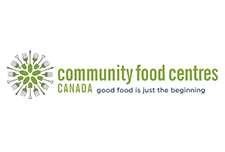
The economic fragility of single women 45-65 years of age is growing, states AFN’s report, On Shaky Ground: Stabilizing the Financial Security of Single Women, released in collaboration with Closing the Women’s Wealth Gap Initiative (CWWG). This report is the first in a series that builds off...

This report explores the financial services complaint experiences of Canadians at various income levels who used the Ombudsman for Banking Services and Investments (OBSI)’s service. The national, not-for-profit organization collected demographic and case data for almost 1,000 closed cases...
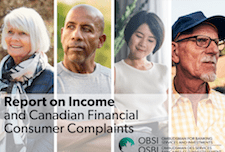
This report presents the findings of extensive research about employable singles on social assistance undertaken by Toronto Employment and Social Services, in partnership with the Ontario Centre for Workforce Innovation. Drawing on data from 69,000 singles who were receiving social assistance in...

Persons with a disability face a higher risk of low income compared to the overall population. This report uses data from the 2014 Longitudinal and International Study of Adults (LISA) to study the relationship between low income and characteristics of people aged 25 to 64 with a disability,...
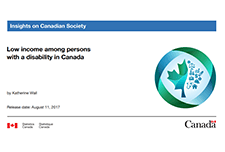
This infographic from Statistics Canada summarizes the results of the Survey of Household Spending, 2017, including average annual expenditures by household...
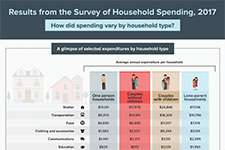
By providing a refundable credit at tax time, the Earned Income Tax Credit (EITC) is widely viewed as a successful public policy that is both antipoverty and pro-work. But most of its benefits have gone to workers with children. Paycheck Plus is a test of a more generous credit for low-income...
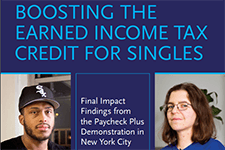
This is a pre-budget presentation from the Government of Canada on the state of the middle class in Canada. Middle class challenges, successes, and government commitments. All Canadians benefit from strong, sustained, and inclusive economic growth and everyone has a real and fair chance at economic...
This new Poverty Trends Scorecard consisting of four reports now presents an update of the information on income, wealth, and inequality. Over three years later, the recovery has yet to fully take hold. The individuals and families who bore the brunt of the 2008–09 recession face continuing...
This article examines changes in the wealth of Canadian families (i.e. total family assets minus total family debt) over the period from 1999 to 2012, with a particular focus on changes across income quintiles. The paper also examines changes in the concentration of wealth across income quintiles,...
Aboriginal women share some of the same demographic and socioeconomic characteristics as other women in Canada; however, there are also many important differences. Generally speaking, Aboriginal people in Canada are defined as three unique and distinct groups: First Nations (North American Indian),...
Being homeless, whether briefly or for an extended period of time, can be profoundly distressing for whoever undergoes the experience. This portrait is the result of an exploratory study on homelessness in 13 communities representing five First Nations in Quebec. The report identifies the principal...
Low income lines are the most commonly used tool for defining and measuring poverty. They provide thresholds below which a household is considered to be living on low income. Low income lines can be constructed in different ways. This brief explains the LICO (Low income cut-off), LIM (Low income...
There has been a resurgence of political interest in Canada in the rather old idea of a universal basic income, sometimes called a guaranteed annual income. Essentially, a basic income is a “no strings attached” transfer from government to individuals or families that can be simpler to...
The Government of Canada is committed to strengthening the middle class and helping low-income Canadians exit poverty so that they have sufficient capabilities to be well and do well. To achieve this goal, we will need to form partnerships, modernize the existing landscape of supports and encourage...
People living in poverty in Canada face multiple barriers. As a country, we can do better to address these persistent challenges. Canada needs a comprehensive national poverty reduction strategy that addresses the complex reality of...
Low-income people need savings and retirement strategies that won’t leave them worse off in their senior years. The purpose of this paper is to educate people who help low-income adults plan for their financial future. Our aim is to put GIS planning at the centre of the pre-retirement discussion...
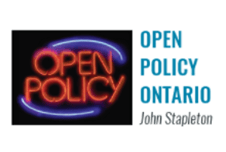
Ensuring the economic well-being of Canada’s growing population of seniors is an important and complex public policy challenge that the new federal government must grapple with. Few disagree with the goal of providing all citizens with the means for a dignified and economically secure retirement....
This Congressional Budget Office (CBO) paper, uses administrative and survey data to examine year-to-year changes in individual earnings and household income since 1984. It also examines variability in earnings and income by factors such as age, sex, and education. In keeping with CBO’s mandate...
Research has shown that social isolation has damaging impacts on health, well-being, and overall quality of life. Low-income people and seniors are among the most vulnerable to social isolation. Conversely, being more socially connected has a positive influence on physical and mental health and...
